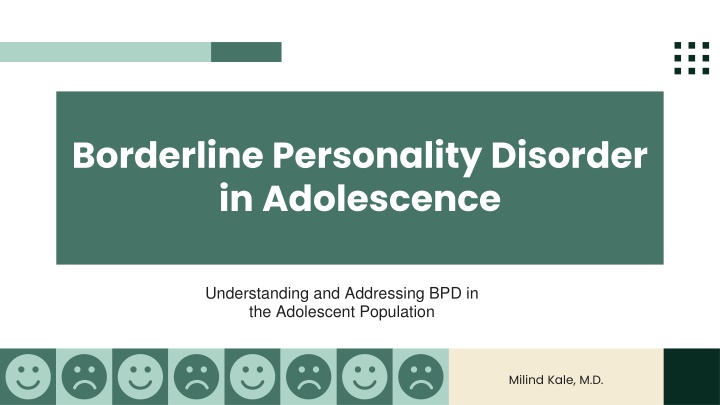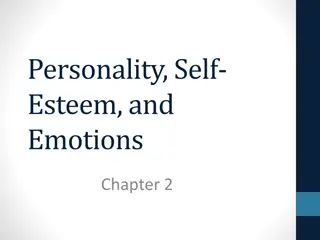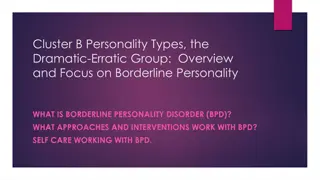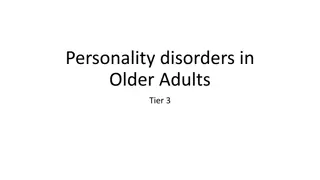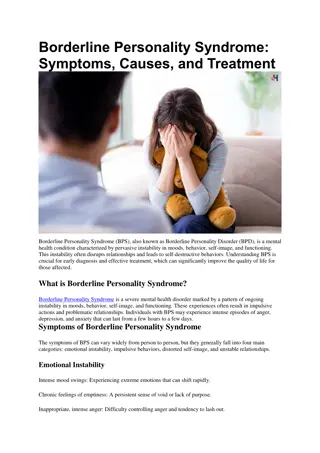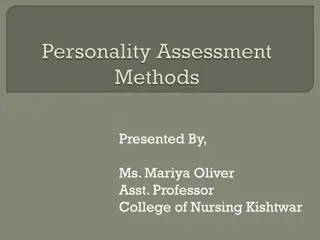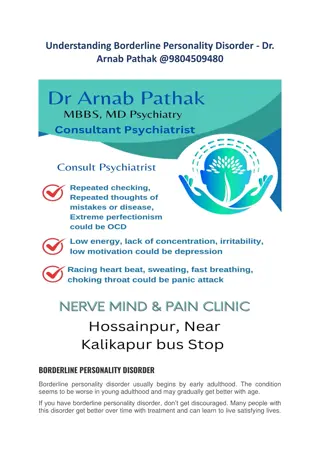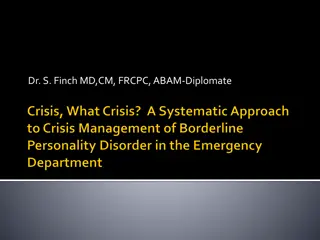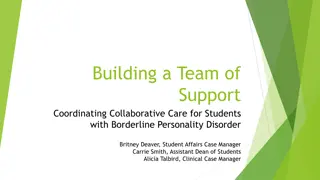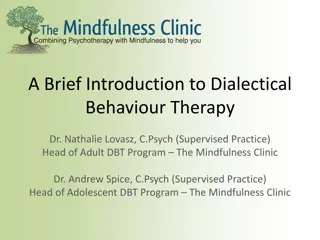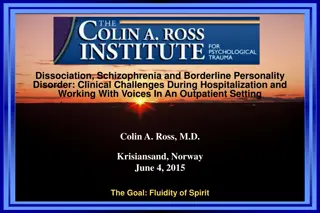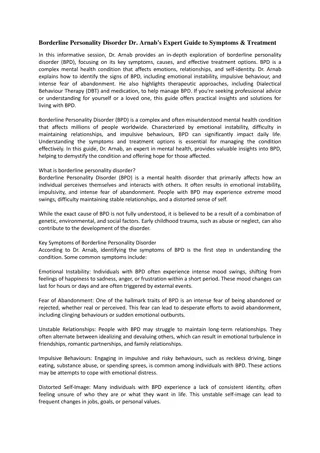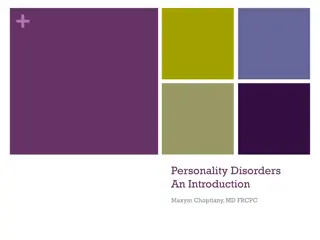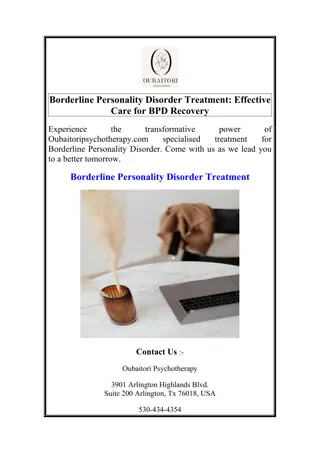Borderline Personality Disorder in Adolescence - Overview and Insights
Borderline Personality Disorder (BPD) in adolescence is characterized by extreme emotional instability, impulsivity, and fear of abandonment. This disorder presents unique challenges in diagnosis and treatment, impacting the individual's relationships, behaviors, and sense of identity. Understanding the key traits and statistics associated with BPD in adolescents is essential for effective intervention and support.
Download Presentation

Please find below an Image/Link to download the presentation.
The content on the website is provided AS IS for your information and personal use only. It may not be sold, licensed, or shared on other websites without obtaining consent from the author.If you encounter any issues during the download, it is possible that the publisher has removed the file from their server.
You are allowed to download the files provided on this website for personal or commercial use, subject to the condition that they are used lawfully. All files are the property of their respective owners.
The content on the website is provided AS IS for your information and personal use only. It may not be sold, licensed, or shared on other websites without obtaining consent from the author.
E N D
Presentation Transcript
Borderline Personality Disorder in Adolescence Understanding and Addressing BPD in the Adolescent Population Milind Kale, M.D.
Table of Contents 1. Definition and Overview 2. Symptoms and Diagnostic Criteria 3. Etiology and Contributing Factors 4. Diagnosis in Adolescents 5. Comorbidities 6. Treatment Modalities 7. Overview of DBT 8. Conclusion and Q&A
Basic Definitions First essential to define what is a personality disorder: Personality is a set of enduring behavioral and mental traits Disorder occurs with enduring maladaptive patterns of behavior, cognition, and inner experience exhibited in many contexts and deviating from an individual s cultural norms
What is BPD? Personality structure primarily composed of instability and impulsivity Driven by fear of abandonment Extreme Instability: Relationships, Behaviors, Emotions, Sense of Self Impulsivity: Suicide Attempts, Self Injurious Behavior, Substance Abuse, Sexual Promiscuity, Eating Behavior Multiple factors including clinical underdiagnosis, stigma against BPD, and difficulty in finding DBT clinicians create unique challenges to proper treatment
Statistical Context Suicidal Adolescents in the ER: 78% Prevalence among Adolescents: 3% Outpatient Clinic: 11% Duration Criteria: One Year
Statistical Context Prevalence of STB s is 7.5% Suicide Is The Second Leading Cause Of Death In 10 14-Year- Old Preadolescent Children s Lifetime prevalence is 2.6% for SA, and STB is 15.1 % and SITB is 6.3% 5 to 11-year-old 43% of STB- focused ER Visits
Nine Traits of BPD Extreme anger, sadness if confronted with the possibility of feeling abandoned Black and white perceptions of others, people are the best person ever or the worst (splitting), perceptions can change often and based on seemingly minor slights Constantly changing self-perception, difficulty articulating personal perspectives or feelings Little regard for personal safety: reckless driving, substance use, frequent sexual encounters Intense Fear of Abandonment Unstable And Intense Interpersonal Relationships Identity Disturbance (Who Am I) Impulsivity Suicidal Thoughts Or Acts Physical pain distracting momentarily from emotional pain Affective Instability (Emotional Regulation) Often feel that emotions control their behavior involuntarily, affect changes within minutes to hours Persistent dysthymic mood, feels that suffering cannot be understood by others Chronic Feelings Of Emptiness Inappropriate Displays Of Anger Followed By Shame And Guilt Transient Psychotic Symptoms (Dissociative States) Contributes to instability in interpersonal relationships Dissociation can be so severe that they seem internally preoccupied
Comorbidities Mood Disorder Anxiety Disorder PTSD
Etiology of BPD Development of mistrustful view of world based on insecure attachment, perceiving others as untrustworthy, rejecting emotional stability Communication of private emotional experiences met by erratic, inappropriate, and extreme responses by caregivers Emotional vulnerability often punished and/or trivialized High emotional reactivity to perceived threats as a method of survival As child develops, mental energy spent on basic survival and protection, less focus on forming stable and secure emotional landscape Repeated, often severe trauma and/or invalidating environment Maladaptive behaviors (excessive risk taking, unstable relationships, self harm, etc)
Life History Theory Fast and Furious Slow COGNITION/ EMOTIONS LOW EMPATHY Heightened threat sensitivity High empathy Low Threat Sensitivity Neuropsychology Low tolerance of Frustration Poor Executive Control High Frustration Tolerance Good Executive Control Personality Neuroticism ^ Agreeableness Conscientiousness Neuroticism Agreeableness ^ Conscientiousness ^ Temperament & Character Novelty seeking ^ Harm avoidance Risk Proneness ^ Novelty seeking Harm avoidance ^ Risk Proneness Interpersonal Behavioral Opportunistic Low Parenting effort Unstable Intimate relationship Altruistic High Parenting effort Stable Intimate relationship Stress Physiology High Cortisol Low Cortisol Other Early Sexual Maturation Late Sexual Maturation
Diagnosis MacLean Screening Instrument for BPD MacLean SIBPD.pdf The Abbreviated Diagnostic Interview For Borderlines (Ab-dib) is a 26-item self-report screening instrument for BPD The Brief (11-item) Borderline Personality Features Scale For Children (BPFSC-11) is a shortened version of the Original BPFSC Differentials to Consider: Bipolar Disorder Other Cluster B Personality Disorders Mood Disorders ADHD PTSD
Importance of Diagnosis in Adolescence Adolescence Characterized by: Identity Disturbance Intensity and functioning of behaviors Positive and negative urgency and impacts on behavior Reasons to diagnose: Adolescence is a key period for the development and manifestation of personality disorders Early diagnosis early intervention improved outcomes Reducing stigma Increase validation through understanding and education Opportunities to address family dynamics and provide guidance for improved communication and safety
Resouces ACCESS Mental Health Connecticut offers real-time psychiatric consultation to medical providers when patients present with mental health and substance use concerns. It is accessible to you and your patients, regardless of insurance. Carelon Behavioral Health s program supports providers working with youth and perinatal women through community-focused expertise and resource coordination. ACCESS Mental Health for Youth Pediatric and Family Care Providers Youth up to age 22, regardless of insurance
Treatment Modalities Essential to treat comorbidities and use lowest number and dose of medications that is effective. Evidence Based Psychotherapies: Dialectical Behavioral Therapy (DBT) has greatest evidence base, accepting two seemingly opposed truths Dialectical Dimensions: Unrelenting Crises And Inhibited Grieving Emotional Vulnerability And Self Invalidation Active Passivity And Apparent Competence Mentalization-Based Treatments (MBT) Schema Focused Therapy (SFT) Transference Focused Psychotherapy (TFT) Systems Training For Emotional Predictability and Problem-solving (STEPPS)
Citations Images: https://www.verywellmind.com/borderline-personality-disorder-4157266 https://www.vectorstock.com/royalty-free-vector/personality-disorder-concept-vector-42478457 https://cdni.iconscout.com/illustration/premium/thumb/personality-disorder-5253961-4391413.png https://static.wixstatic.com/media/df5ee2_7524fc3f8d6b4d8f84822e1bca3f3d6c~mv2.png/v1/fill/w_ 347,h_345,al_c,q_85,usm_0.66_1.00_0.01,enc_auto/DBT.png Citations: Br ne, M. (2016). Borderline Personality Disorder: Why fast and furious ? Evolution, Medicine, and Public Health, (2016) 52-66. doi:10.1093/emph/eow002 Berk, M., et al. (2024). Remission, recovery, and relapse. Journal of the American Academy of Child & Adolescent Psychiatry, 63(9), September 2024. Ayer, L., et al. (2024). Emotional experiences and outcomes. Journal of the American Academy of Child & Adolescent Psychiatry, 63(9), September 2024.
